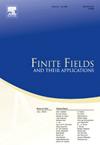二属曲线超特性的重性- 1定理
IF 1.2
3区 数学
Q1 MATHEMATICS
引用次数: 0
摘要
Igusa在1958年证明了决定勒让德形式椭圆曲线超奇异性的多项式是可分离的。本文对Rosenhain形式的2属曲线得到了一个类似的结果。更确切地说,我们证明了确定曲线超特性的理想在每一个超特殊点上都具有多重性。Igusa使用了一个Picard-Fucks微分算子来湮灭高斯超几何级数。我们将使用三变量超几何微分方程的Lauricella系统(D型)。本文章由计算机程序翻译,如有差异,请以英文原文为准。
The multiplicity-one theorem for the superspeciality of curves of genus two
Igusa proved in 1958 that the polynomial determining the supersingularity of elliptic curves in Legendre form is separable. In this paper, we get an analogous result for curves of genus 2 in Rosenhain form. More precisely we show that the ideal determining the superspeciality of the curve has multiplicity one at every superspecial point. Igusa used a Picard-Fucks differential operator annihilating a Gauß hypergeometric series. We shall use the Lauricella system (of type D) of hypergeometric differential equations in three variables.
求助全文
通过发布文献求助,成功后即可免费获取论文全文。
去求助
来源期刊
CiteScore
2.00
自引率
20.00%
发文量
133
审稿时长
6-12 weeks
期刊介绍:
Finite Fields and Their Applications is a peer-reviewed technical journal publishing papers in finite field theory as well as in applications of finite fields. As a result of applications in a wide variety of areas, finite fields are increasingly important in several areas of mathematics, including linear and abstract algebra, number theory and algebraic geometry, as well as in computer science, statistics, information theory, and engineering.
For cohesion, and because so many applications rely on various theoretical properties of finite fields, it is essential that there be a core of high-quality papers on theoretical aspects. In addition, since much of the vitality of the area comes from computational problems, the journal publishes papers on computational aspects of finite fields as well as on algorithms and complexity of finite field-related methods.
The journal also publishes papers in various applications including, but not limited to, algebraic coding theory, cryptology, combinatorial design theory, pseudorandom number generation, and linear recurring sequences. There are other areas of application to be included, but the important point is that finite fields play a nontrivial role in the theory, application, or algorithm.

 求助内容:
求助内容: 应助结果提醒方式:
应助结果提醒方式:


